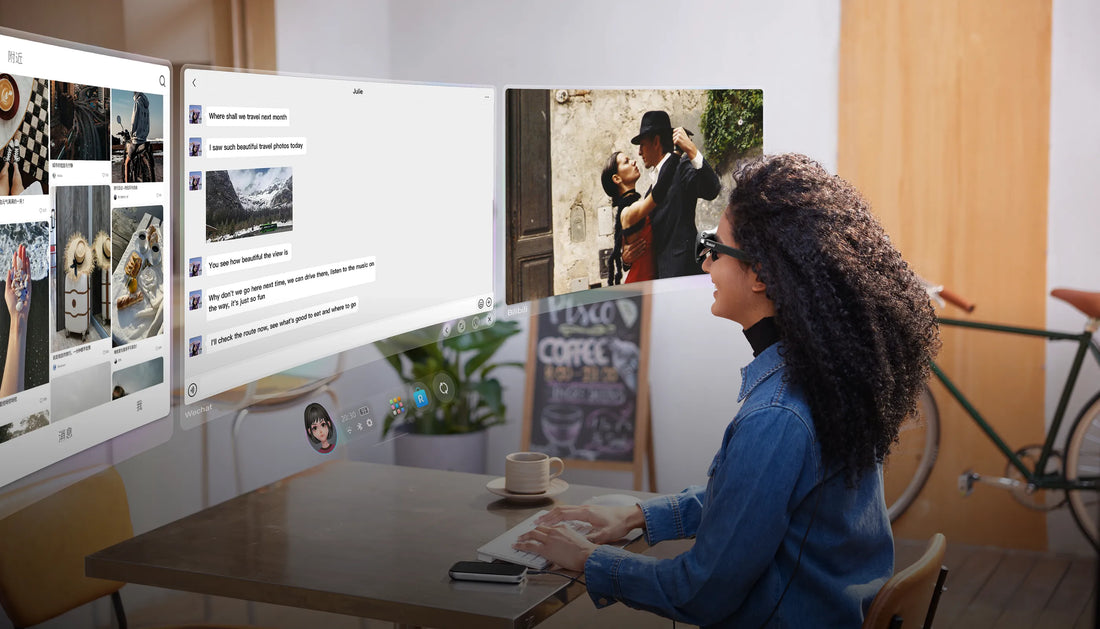Can I Use AR if I Wear Glasses? How AR Smart Glasses for Myopia Work?

In recent years, VR+AR devices have experienced explosive growth in the consumer market. According to the latest data from IDC[1], global AR/VR headset shipments will grow 10% in 2024. These immersive devices are increasingly becoming a part of our daily lives, whether for entertainment, education, or professional applications. Notably, among the growing user base of VR and AR, the proportion of myopic individuals is significant.
So, can glasses-wearing myopic individuals use AR smart glasses? We will address this common concern and offer practical reference suggestions for myopic users when choosing and using these devices in this blog.

Problems of Myopic Users Wearing AR Smart Glasses
1. Degraded Visual Quality
Traditional AR glasses are typically designed with normal-vision users in mind. Myopic users who wear them directly experience blurred virtual images. Some users attempt to wear their prescription glasses underneath AR smart glasses, but this glasses-over-glasses approach causes multiple optical distortions:
l First, the air gap between the two lens layers creates additional refraction;
l Second, the optical center of the prescription lenses rarely aligns perfectly with the AR display system;
l Finally, reflections between lenses cause ghosting and glare.
2. Compatibility Issues
Another significant problem is compatibility. AR smart glasses feature specific optical structures and frame configurations, often lacking adequate space to comfortably accommodate prescription eyewear. This issue becomes particularly acute with fully enclosed AR devices, where the sealed design physically prevents simultaneous wear of corrective glasses. Furthermore, the combined weight distribution of two stacked frames frequently leads to pressure points on the ears and nasal bridge, with most users reporting noticeable discomfort within minutes of use.
3. Wearing Inconvenience
The double-wearing approach not only affects visual experience but also creates numerous practical inconveniences. Users must repeatedly adjust the positioning of both glasses, which is especially challenging to maintain stability during movement. In scenarios requiring frequent removal (such as during conversations), the process becomes particularly troublesome. More critically, this unstable wearing method compromises the eye-tracking accuracy of AR smart glasses, leading to failed interactive functions. In some cases, this improper wearing method may even cause physical damage to either the prescription glasses or the AR device.
How Rokid AR Smart Glasses Solve These Issues
1. Built-in Diopter Adjustment
Our Rokid AR smart glasses innovatively integrate an adjustable electronic diopter system, ranging from 0.00D (no correction) to -6.00D (myopia correction). This system precisely moves internal optical components to change the focal distance of the virtual image, effectively "building in" myopia correction functionality. Users can simply adjust the knob on the device to find the optimal visual setting without any tools.
2. Prescription Lens Support
If your prescription falls outside the built-in adjustment range or if you have hyperopia or astigmatism, our glasses can accommodate other prescription lens solutions.
Additionally, we offer a professional custom lens service. Users can provide the prescription information to obtain correction lenses that perfectly match the AR optical system. These lenses are made of ultra-thin, high-refractive-index materials and are coated with a special anti-reflective coating. Most importantly, the custom lenses are installed as part of the optical path inside the device rather than being added externally, thus completely avoiding the optical loss associated with traditional methods.
3. Comfort and Wearability
At Rokid, we place great emphasis on enhancing wearing comfort. Our smart glasses for myopia are designed to be lightweight, such as the Rokid AR Spatial, which weighs only 75 grams, ensuring that even prolonged use does not impose an excessive burden on the face. The comfortable nose bridge is ergonomically engineered to evenly distribute pressure, reduce discomfort, and prevent skin indentations.
